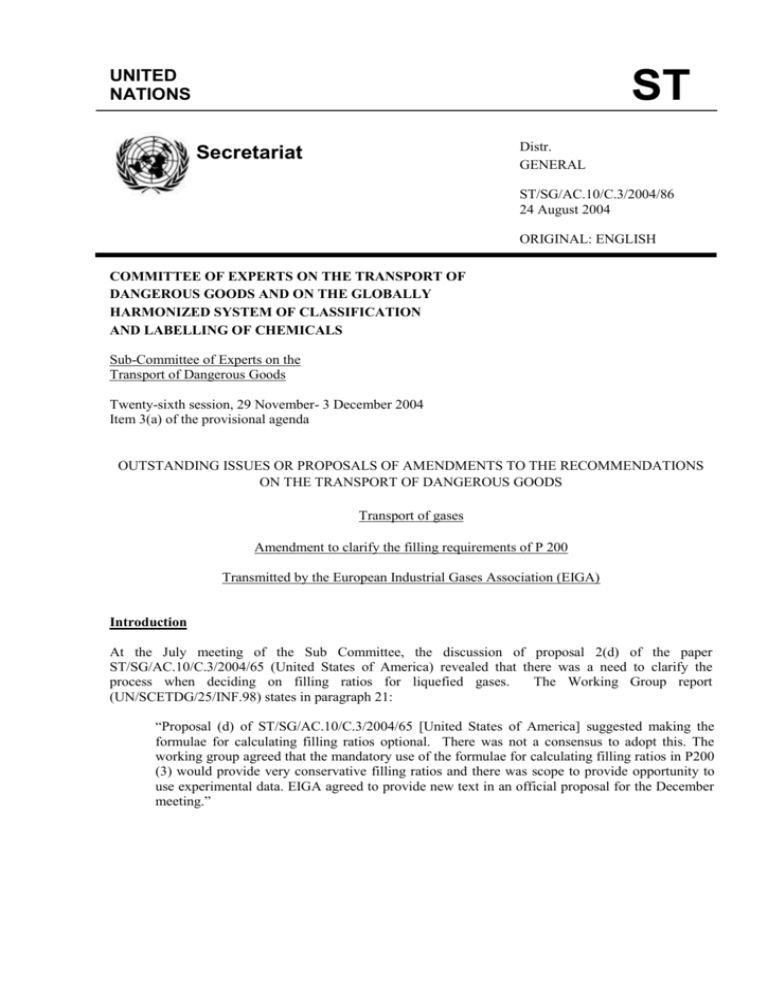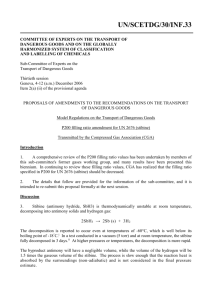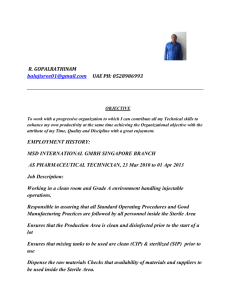UN Proposal
advertisement

UNITED NATIONS Distr. GENERAL Secretariat ST ST E ST/SG/AC.10/C.3/2004/86 24 August 2004 ORIGINAL: ENGLISH COMMITTEE OF EXPERTS ON THE TRANSPORT OF DANGEROUS GOODS AND ON THE GLOBALLY HARMONIZED SYSTEM OF CLASSIFICATION AND LABELLING OF CHEMICALS Sub-Committee of Experts on the Transport of Dangerous Goods Twenty-sixth session, 29 November- 3 December 2004 Item 3(a) of the provisional agenda OUTSTANDING ISSUES OR PROPOSALS OF AMENDMENTS TO THE RECOMMENDATIONS ON THE TRANSPORT OF DANGEROUS GOODS Transport of gases Amendment to clarify the filling requirements of P 200 Transmitted by the European Industrial Gases Association (EIGA) Introduction At the July meeting of the Sub Committee, the discussion of proposal 2(d) of the paper ST/SG/AC.10/C.3/2004/65 (United States of America) revealed that there was a need to clarify the process when deciding on filling ratios for liquefied gases. The Working Group report (UN/SCETDG/25/INF.98) states in paragraph 21: “Proposal (d) of ST/SG/AC.10/C.3/2004/65 [United States of America] suggested making the formulae for calculating filling ratios optional. There was not a consensus to adopt this. The working group agreed that the mandatory use of the formulae for calculating filling ratios in P200 (3) would provide very conservative filling ratios and there was scope to provide opportunity to use experimental data. EIGA agreed to provide new text in an official proposal for the December meeting.” ST/SG/AC.10/C.3/2004/86 page 2 The tables provide filling ratios for specified test pressures and substances, but the option when working with substances or mixtures or test pressures not listed in P200 is poorly expressed. The current wording allows two routes for liquefied gases either use the figures in the table or use the formulae given in paragraph 3(b) or 3(c) the text. These formulae are intentionally very conservative because they must allow for the wide range of variations in the properties of liquefied gases. However, safety would not be compromised if accurate substance properties were used instead to make the calculation. The P200 is based upon the ADR/RID of 1999 and in that text it was clear that use of the formulae was mandatory only in the case when the material property data was unavailable. During the development of the UN text, the meaning was changed in a way that is unnecessarily restrictive. Therefore EIGA proposes to revise the text by as shown in the following copy of P200 paragraph 3. The formulae are used, not in the absence of filling data in the table, they are used when the substance properties are not known. Justification Safety implications None; the key criteria of not exceeding the limits at the head of paragraphs 3(b) and 3(c) are still observed. The same conservative rules apply if the properties are unknown. Feasibility No problem; the change reflects national filling practice in many parts of the world. Enforceability The filler will have to be able to demonstrate that his chosen filling ratios are safe, as he has at present when deviating from the prescriptions of P200 Table 2. ST/SG/AC.10/C.3/2004/86 page 3 P200 (3) PACKING INSTRUCTION (cont'd) P200 In no case shall pressure receptacles be filled in excess of the limit permitted in the following requirements: (a) For compressed gases, the working pressure shall be not more than two thirds of the test pressure of the pressure receptacles. Restrictions to this upper limit on working pressure are imposed by special packing provision ‘o’. In no case shall the internal pressure at 65 °C exceed the test pressure. (b) For high pressure liquefied gases, the filling ratio shall be such that the settled pressure at 65 °C does not exceed the test pressure of the pressure receptacles. The use of test pressures and filling ratios other than those in the tables is permitted provided that the above criterion is met, except where special packing provision “o” applies. For high pressure liquefied gases and gas mixtures for which insufficient data are available not provided in the table, the maximum filling ratio (FR) shall be determined as follows: FR = 8.5 x 10-4 x dg x Ph where FR dg Ph = = = maximum filling ratio gas density (at 15 °C, 1 bar)(in g/l) minimum test pressure (in bar) If the density of the gas is unknown, the maximum filling ratio shall be determined as follows: FR = Where FR Ph MM R = = = = Ph x MM x 10-3 R x 338 maximum filling ratio minimum test pressure (in bar) molecular mass (in g/mol) 8.31451 x 10-2 bar.l/mol.K (gas constant) For gas mixtures, the average molecular mass is to be taken, taking into account the volumetric concentrations of the various components. (c) For low pressure liquefied gases, the maximum mass of contents per litre of water capacity (filling factor) shall equal 0.95 times the density of the liquid phase at 50 °C; in addition, the liquid phase shall not fill the pressure receptacle at any temperature up to 60 °C. The test pressure of the pressure receptacle shall be at least equal to the vapour pressure (absolute) of the liquid at 65 °C, minus 100 kPa (1 bar). For low pressure liquefied gases for which filling data are not available provided in the table, the maximum filling ratio shall be determined as follows: where (d) FR = (0.0032 x BP – 0.24) x d1 FR BP d1 = = = maximum filling ratio boiling point (in Kelvin) density of the liquid at boiling point (in kg/l) For acetylene, dissolved, UN 1001, and acetylene, solvent free, UN 3374, see (4), special packing provision p. __________________





